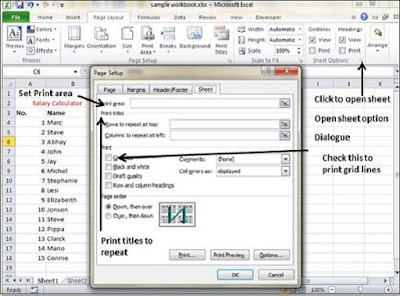Function
library
In Excel, we have 300+ functions and they are available in the
formulas tab under the function library group. And there is no need to learn
every formula for we can find formulas category wise such as:- Financial,
Logical, Text, Date & Time, Lookup & Reference, Math & Trig, many
more.
Define
names
We use this option to define the name of
a cell, range and the list of the already defined name can be viewed in Name
manager and we can edit it if we want to change the range or cell reference of
any defined name. Also, we can use the defined name in Formulas.
Formula
auditing
This option helps us to identify the
relation of formulas. By using Trace precedent, we get to know on which cell
formula cell is based. Trace dependents are used to know if active cell is
being used in any formula. When we use trace precedent and trace dependents the
arrows get inserted automatically and, to remove the arrows, we use Remove
Arrows. Show formula is a self-explained word; it is used to show the formula
in the sheet. Error checking is used to check the error in the sheet. Evaluate
formula option is used to evaluate the formula step by step.
calculation
If we want to switch the calculation from
automatically to manually calculation and manually to automatically
calculation, then we can do it by using the Calculation option. We use
Calculate Now and Calculate Sheet option if automatic calculation is turned
off.
Page
layout
Many of the commands you'll use to
prepare your workbook for printing and PDF export can be found on the Page
Layout tab.
These commands let you control the way your content will appear on a printed
page, including the page orientation and margin
size.
Other page layout options, such as print titles and page breaks, can
help make your workbook easier to read.
Themes
The
first group that we will look at is the Themes group. Themes in Microsoft
Excel provide a unique and professional look to your Workbooks. They can
do this by using an assortment of font styles, color schemes and graphical
effects.
Page
setup
we have many different choices for our
Microsoft Excel worksheet layout . this tab contain themes , page
setup ,scale to fit ,sheet option ,arrange.
Page
orientation
Page orientation refers to how output is
printed on the page. If you change the orientation, the onscreen page breaks
adjust automatically to accommodate
the
new paper orientation.
Choose Page Layout » Page Setup » Orientation »
Portrait or Landscape.
•Portrait −
Portrait to print tall pages (the default).
•Landscape −
Landscape to print wide pages. Landscape orientation is useful when you have a
wide range that doesn’t fit on a vertically oriented page.
Page
break
If you don’t want a row to print on a
page by itself or you don't want a table header row to be the last line on a
page. MS Excel gives you precise control over page
breaks.
Insert Horizontal Page Break −
For example, if you want row 14 to be the first row of a new page, select cell
A14. Then choose Page Layout » Page Setup Group » Breaks »
Insert Page Break.
Background
Unfortunately, you cannot have a background image on your printouts. You may havenoticed the Page Layout » Page Setup » Background command. This button displays a dialogue box that lets you select an image to display as a background. Placing this control among the other print-related commands is very misleading. Background images placed on a worksheet are never printed.
margins
Margins are the unprinted areas along the sides, top, and bottom of a printed page. All printed pages in MS Excel have the same margins. You can’t specify different margins for different pages.You can set margins by various ways as explained below.
•Choose Page Layout » Page Setup » Margins drop-down list, you can select Normal, Wide, Narrow,Print
titles
If your worksheet uses title headings,
it's important to include these headings on each page of your printed
worksheet. It would be difficult to read a printed workbook if the title
headings appeared only on the first page. The Print
Titles command
allows you to select specific rows and columns to appear on each page.
Sheet
options
MS Excel provides various sheet options for printing purpose like generally cell
gridlines aren’t printed. If you want your printout to include the gridlines, Choose Page Layout » SheetOptions group » Gridlines » Check Print.
Scale
to fit
Use the Scale to Fit settings in Excel
2010 if you need to make a worksheet fit when you must get a few last rows or
columns on a single page. You can use the Width, Height, and Scale options in
the Scale to Fit group of the Page Layout tab to change these settings. These
options are also available on the Page tab of the Page Setup dialog box.
Arrange
The last group in the Page Layout Tab is
Arrange. This is primary used with pictures or images. Once you have such
an element in your workbook, you can then use Arrange commands to position the
item relative to your data. For now we will skip over this and come back to it
when we go over the Insert Tab.













